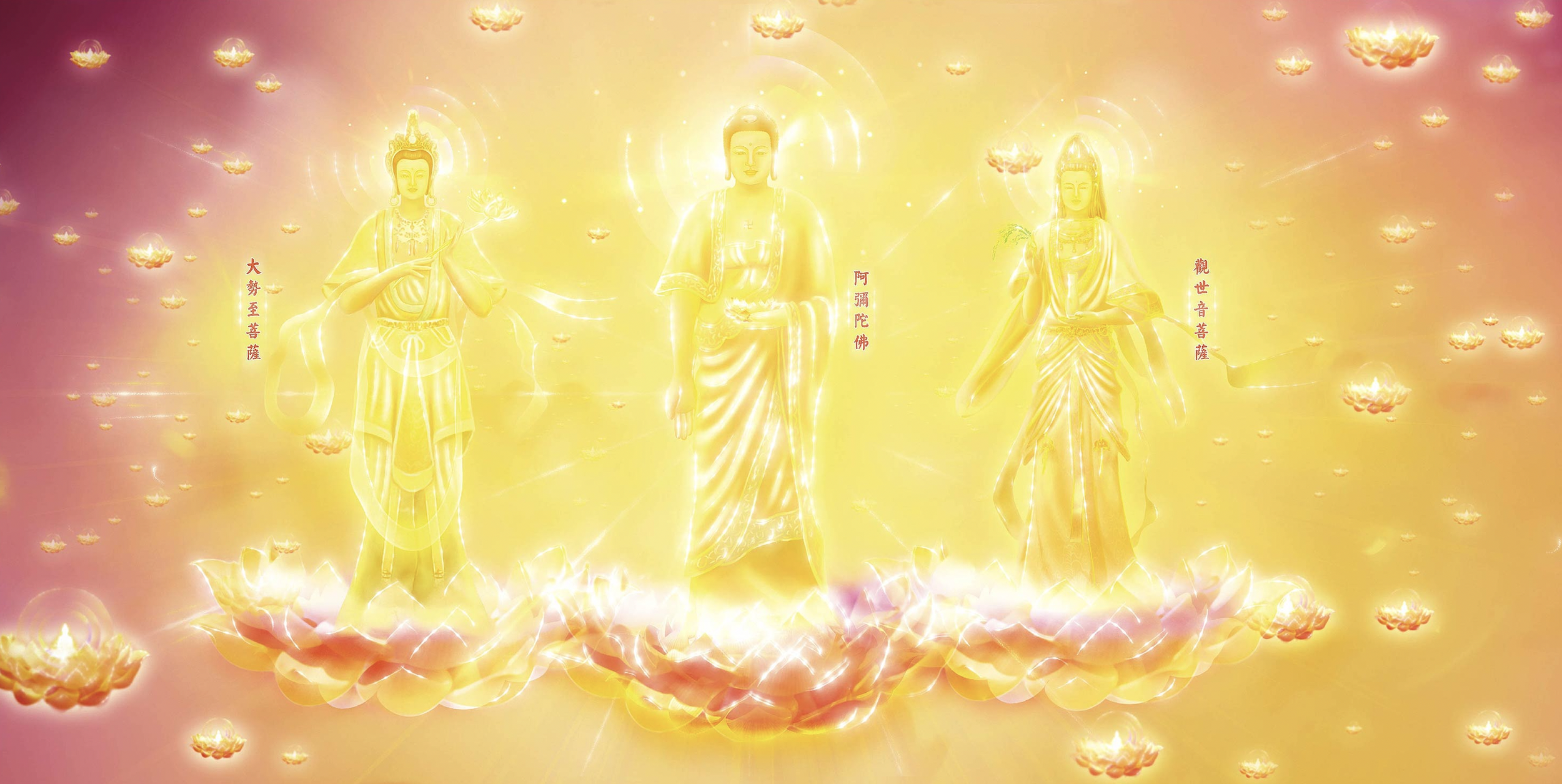The Infinite Life Sutra 无量寿经
The Infinite Life Sutra
The Buddha Speaks of the Mahayana
Infinite Life Adornment Purity Impartiality and Enlightenment Sutra
佛说大乘无量寿庄严清净平等觉经
or simply
The Infinite Life Sutra
(The Longer Sukhāvatīvyūha Sūtra)
Compiled Version by Upāsaka Xia Lianju
Introduction
The Infinite Life Sutra (or the Longer Sukhāvatīvyūha Sūtra) is one of the five Pure Land sutras in Chinese Pure Land Buddhism, and one of the three primary Pure Land sutras, along with the Amitabha Sutra (the Shorter Sukhāvatīvyūha Sūtra), and the Visualization Sutra (the Amitāyurdhyāna Sūtra). It is the most detailed, complete, and longest Pure Land sutra. It most comprehensively describes the Western Pure Land called “Sukhāvatī” and details how Amitabha Buddha created it. His Forty-Eight Great Vows and the Three Levels of Rebirth in the Pure Land, along with many other descriptions and teachings are explained in this holy text.
Some scholars believe that the Longer Sukhāvatīvyūha Sūtra was compiled in the age of the Kushan Empire in the first and second centuries and became popular in the Gandhāra region. According to historical records, between 147 to 713 CE, this sutra was translated over twelve times from the original Sanskrit into Chinese. It is rare for a sutra to have so many different translations. It can be deduced that, most likely, the Buddha had expounded this Dharma many times due to its great significance.
Unfortunately, seven translations have gone missing, and now only five remain in the Chinese Buddhist Canon. They are as follows:
1) The Infinite Life Purity Impartiality and Enlightenment Sutra (《无量清净平等觉经》), translated in the Han period by Kusana translator Tripitaka Lokakṣema (后汉月支三藏支娄迦谶), who arrived in Luoyang (the ancient capital of China) in 164 CE and translated works until 186 CE;
2) The Buddha Speaks of the Infinite Life Sutra (《佛说无量寿经》), translated by Indian Buddhist monk Sanghavarman (曹魏康僧铠)in 252 CE at the White Horse Temple in Luoyang - the ancient capital of China;
3) The Larger Amitabha Sutra (《大阿弥陀经》), translated by Zhi Qian (吴月氏优婆塞支谦) who came from the Kushan Kingdom to Luoyang during the decline of the Han Dynasty and translated the sutra sometime between 223 and 253 CE;
4) The Assembly of Infinite Life Tathāgata (《无量寿如来会》), the fifth assembly of the Mahāratnakūṭa Sutra (《大宝积经》), translated by Bodhiruci (菩提流支) from the Tang Dynasty;
5) The Mahayana Infinite Life Adornment Sutra (《大乘无量寿庄严经》), translated by Faxian from the Nalanda Monastery in the Northern Song Dynasty.
Due to the different translations of the Infinite Life Sutra, with slight variations. Some are briefer, some are more in-depth, and some include a different number of vows, including sets of twenty-four vows, thirty-six vows and forty-eight vows. The one translated by Sanghavarman with forty-eight great vows has so far been the most popular.
There have also been a few compiled versions of the Infinite Life Sutra. What we study now is a composition of the five remaining versions of the Infinite Life Sutra from the Chinese Buddhist Canon by Upāsaka Xia Lianju (夏莲居). One can use either the version by Sanghavarman or Xia Lianju. After comparing these two versions against each other, we recommend the compiled version by Upāsaka Xia Lianju as the content is more detailed and comprehensive. Venerable Master Chin Kung and my teacher Venerable Master Renshan both used this version when expounding the Infinite Life Sutra. For instance, the version translated by Sanghavarman did not mention if other Mahayana practitioners (i.e., practitioners of different Mahayana paths) can also seek rebirth to the Pure Land if they Nianfo, whereas the compiled version deals with this aspect clearly in Chapter 24 – Three Levels of Rebirth (see Jiawen’s translation).
The compiled version by Xia Lianju has been well-received and highly praised since being published, and it is also now the most popular version studied across China and around the world among Chinese Pure Land Buddhists.
Upāsaka Xia Lianju (1884- 1965) was an eminent lay Buddhist during the era of the Republic of China. After reaching middle age, he dedicated the rest of his life to spreading the Pure Land Dharma. In 1932, he spent three years compiling the current version of the Infinite Life Sutra, based on the five existing ancient translations of the Pure Land sutras, without changing a single word and whilst taking into consideration all the other compiled versions. After three years of hard work, he finally completed the current version and entitled it:
“The Buddha Speaks of the Mahayana Infinite Life Adornment Purity Impartiality and Enlightenment Sutra.” (《佛说大乘无量寿庄严清净平等觉经》)
Since this version was published, this sutra became prevalent all over China and the world over, due to its easy readability, use of beautiful and eloquent language, and detailed content.
There have also been a few commentaries written on this compiled version, such as “An Explanation on the Buddha Speaks of the Mahayana Infinite Life Adornment Purity Impartiality and Enlightenment Sutra” (《佛说大乘无量寿庄严清净平等觉经解》) by the eminent Upāsaka Huang Nianzu (黄念祖老居士, 1913-1992) and “A Brief Explanation on the Mahayana Infinite Life Adornment Purity Impartiality and Enlightenment Sutra” (《大乘无量寿经简注易解》) by the most Venerable Master Chin Kung (also spelled “Jingkong” 净空老法师, 1927-2022).
We will endeavour to translate the whole of the Infinite Life Sutra, adding brief footnotes and annotations. Hopefully, it will be more easily accessible for many people worldwide to study this sutra. For now, we have translated the Forty-Eight Great Vows of Amitabha Buddha from Chapter Six, one of the most critical chapters in the sutra. We will also translate the remaining chapters soon.
Here is a wonderful translation of the Infinite Life Sutra by John Walker. You can download it here. (Jiawen is also working on a translation)
You can also download the key chapter: The Forty-Eight Great Vows of Amitabha Buddha (translated by Jiawen) here. When you read the sutra, you can combine it with Jiawen’s sutra talk series on the Forty-Eight Great Vows (a total of eight sessions here), in which she goes through each vow in great detail to help you gain a more thorough understanding.
Three Sages of the Western Pure Land

